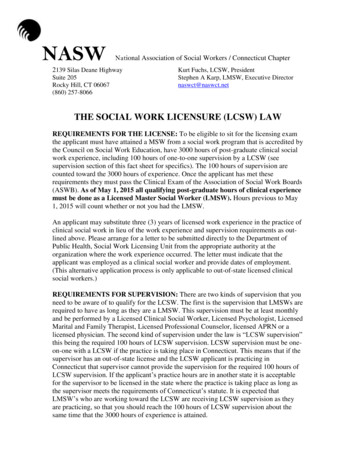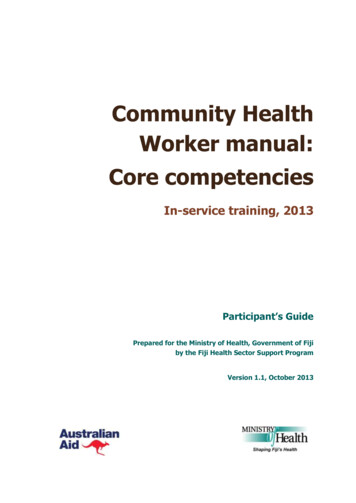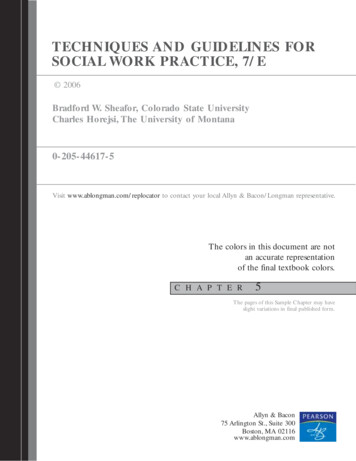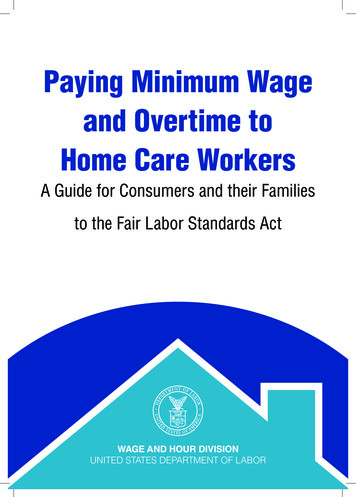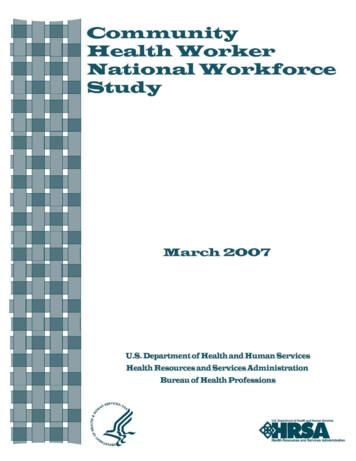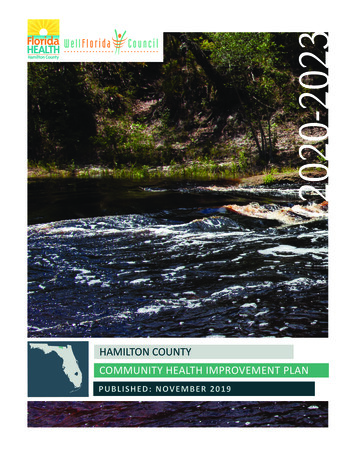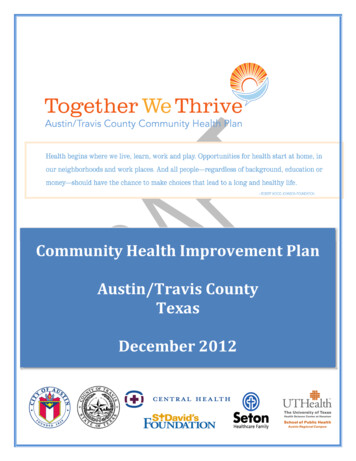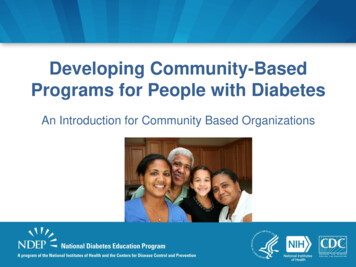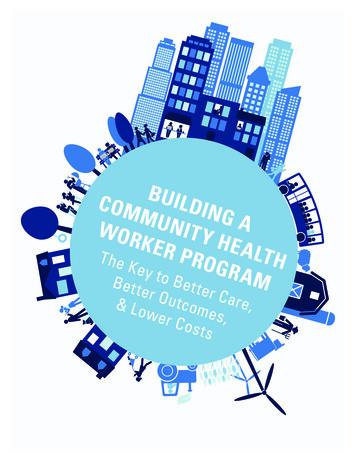
Transcription
BC O M U I L DI NGAMUNWORIT YHE AK ERLPT heTRH OKeyGRtAoMB Be t tetteer Car Our e,t co m& Loes, w erC os ts
Building a Community Health Worker Program:The Key to Better Care, Better Outcomes, & Lower Costsby:Beth A. Brooks, PhD, RN, FACHESheila Davis, DNP, ANP, FAANLoraine Frank-Lightfoot, DNP, MBA, RN, NEA-BCPamela A. Kulbok, DNSc, RN, PHCNS-BC, FAANShawanda Poree, MBA, BSN, RNLisa Sgarlata, DNP, MSN, MS, RN, FACHEJuly 2018AcknowledgmentsBuilding a Community Health Worker Program: The Key to Better Care, Better Outcomes, & Lower Costs was supported bythe Robert Wood Johnson Foundation Executive Nurse Fellows Program. The contents are the sole responsibility of theauthors and do not represent the official views of the Robert Wood Johnson Foundation.The authors would like to acknowledge the following individuals and organizations for their invaluable assistance andcontributions to this work:Jim Adams, Copyeditor, New York, NYHeidi Blossom, MSN, RN, Care Transitions Coordinator, The Association of Montana Health Care Providers, Billings, MTJoan Cleary, M.M., Joan Cleary Consulting, St. Paul, MNThe College of Wooster, Wooster, OHVictoria DeFiglio, BSN, RN, Associate Clinical Director, Camden Coalition of Health care Providers, Camden, NJJose Fernandez, Creative Director, 17A Creative, New York, NYJean M. Gunderson, DNP, RN, Community Engagement Coordinator, Mayo Clinic, Rochester, MNEllen B. Loring, MEd, Board Certified Executive Coach, Loring Leadership, LLC, Colorado Springs, COMike Ryan, Copywriter, Columbus, OHWooster Community Hospital, Wooster, OHRecommended citation:Brooks, B.A., Davis, S., Frank-Lightfoot, L., Kulbok, P.A., Poree, S., & Sgarlata, L. (2014, 2018). Building a CommunityHealth Worker Program: The Key to Better Care, Better Outcomes, & Lower Costs. Published by CommunityHealth Works.Chicago: Authors. 2014, 2018 CommunityHealth Works. The authors are listed alphabetically; each contributed equally to this publication.
In April 2017, the American Hospital Association (AHA) formed a strategic alliance with the National Urban League (NUL) toadvance health equity and diversity in health care leadership in communities across the United States. The organizationscollaborate to promote policy solutions to persistent challenges impacting the health of vulnerable communities, matchNUL leaders with opportunities on governing boards at hospitals and health systems, and develop resources and sharebest practice on community health worker programs. As a part of the community health worker initiative, the AHA and theNUL hosted the Community Health Worker Consortium in Chicago, in November of 2017. Representatives from hospitaland health system organizations, federal and state agencies, academic institutions and community-based organizationsattended the consortium. The session focused on three main topics: defining community health workers, credentialing ofcommunity health workers, and funding sources and strategies for sustainability. Following the consortium, the AHA andthe NUL, along with CommunityHealth Works, formed a strategic advisory group that worked together to apply findingsfrom the consortium to the Building A Community Health Worker Program: The Key to Better Care, Better Outcomes,& Lower Costs toolkit. This resource is intended to help administrative and clinical leaders implement successful andsustainable community health worker programs.Special contributions and updates (July 2018):Leticia Boughton-Price, President & CEO, Illinois CommunityHealth Worker Association, and Section Chair, CommunityHealth Workers, American Public Health AssociationJay Bhatt, DO, MPH, MPA, Senior Vice President and Chief Medical Officer, American Hospital Association, and President,Heath Research and Education TrustNimaako Brown, MPH, Senior Director of Health and Wellness, National Urban LeagueHelen Margellos-Anast, MPH, Director of Community Health Innovations, Sinai Health SystemJonathan McKinney, MPH, Richard J. Umbdenstock Institute for Diversity Executive Fellow, American Hospital AssociationJennifer Snow, MBA, Director of Accountable Communities, Greenville Health SystemGrace Tate, Executive Vice President, Buffalo Urban LeagueScott Tornek, MBA, Chief Strategy Officer, Penn Center for Community Health Workers, Penn MedicineLaura Vail, Director, Office of Inclusion and Health Equity, Cone HealthCynthia Washington, Interim President & CEO, Institute for Diversity and Health Equity, American Hospital AssociationKimberlydawn Wisdom, MD, MS, Senior Vice President of Community Health & Equity and Chief Wellness Officer, HenryFord Health System
CONTENTSAcknowledgments2Executive Summary5Chapter 1: Introduction and Background6Chapter 2: Defining the CHW Role12Chapter 3: Implementing a CHW Program18Chapter 4: Strategic Stakeholders31Chapter 5: Implementation Considerations and FAQs36Chapter 6: Case Studies41Chapter 7: Tools and Templates46Resources50References53Bibliography56
EXECUTIVE SUMMARYBACKGROUND:Imagine a program that allows hospitals and health systems to address the needs of high-risk or at-risk populations(multiple chronic conditions, premature birth), social determinants of health, readmissions, emergency department(ED) over usage and provide direct services.This is the true potential of a Community Health Worker (CHW) Program.A growing body of evidence-based practices demonstrates that implementing a CHW program is a solution thatdelivers meaningful and measurable results to hospital and health systems. Research has shown that CHWprograms have resulted in an average savings of 2,245 per patient served, and hospitals and health systems cansave 2.28 for every 1.00 it invests in a CHW program – all while improving the health outcomes of patients andcommunities.Just as you do, we recognize the need for novel approaches to expand patient access to primary care services,decrease unnecessary ED visits and patient readmissions, prevent disease, increase patient adherence, improvehealth and wellness and meet the needs of an aging population.This CHW toolkit will cover what CHW programs are and what is suggested to implement a program on your own aswell as the benefits to your organization, your patients and your community.Toolkit highlights include:— Best practice evidence— Case studies, resources and references— Definitions of key terms— Funding considerations— Talking points for strategic stakeholders— Program implementation considerations— Sample job tools and templates used by CHWs— Suggested outcome measuresUsing the information within the toolkit, you will be able to design and implement a CHW program to serve thepatients within your community and achieve better patient experience, improve health and increase affordability.1: EXECUTIVE SUMMARY5
1INTRODUCTION AND BACKGROUNDAS THE DEMAND FOR CARE INCREASES, SO WILL THE ROLE OF CHWsThe health care system in the United States is undergoing a monumental transformation. Escalating costs havelimited the public’s ability to access affordable, high-quality health and medical care. With the implementation of thePatient Protection and Affordable Care Act (U.S. House of Representatives, 2010), commonly called the AffordableCare Act (ACA), health care insurance coverage is expected to grow exponentially in the years to come.Obviously, there is a need for novel approaches to providing access to primary care – approaches that will helphospitals and health systems to decrease readmissions and emergency department visits; increase patientadherence; improve health and wellness; reduce risk; prevent disease; and meet population needs identified by ACAmandated Community Health Needs Assessments (CHNA).One such approach is the implementation of a CHW Program. A growing body of evidence points to the positivehealth impacts by CHWs who address the needs of individuals facing barriers to health care access due to culturalpractices, race, ethnicity, language, literacy, geography, income, ability, or other related factors. In coordination withmainstream health care providers, CHWs offer health, wellness, and disease prevention and management servicesin order to decrease health disparities and achieve improved health outcomes, better patient experience, andincreased affordability.This toolkit provides essential information and strategies to leaders in mainstream health care settings so that theycan more easily design and implement a successful CHW program in the communities they serve.WHAT IS A COMMUNITY HEALTH WORKER?The concept of the CHW varies from country to country. An increasing number of nations around the world aremoving toward the use of multipurpose CHWs equipped with enough knowledge to deal with a variety of primarysymptoms. Some other nations still follow the more traditional approach, in which a CHW focuses on one conditionor disease. In either case, these paraprofessionals help cover the basic health care needs of populations and referwhen necessary.61: INTRODUCTION AND BACKGROUND
The United States lags on both fronts — we have been comparatively slow to adopt the use of CHWs at all. Manyother countries have found that when CHWs are equipped with knowledge and skills to address a variety of concernsthey have been more "successful" than a CHW that focuses on one condition or disease. As the rest of the world isrealizing the potential of the CHW, we can learn from their experience and adopt that model in the U.S.A CHW uses a multipurpose approach to the provision of health care services. Historically, the training of CHWshas generally followed the traditional approach mentioned on the previous page, in which the CHW focuses on onecondition such as diabetes or heart disease or HIV/AIDS. As a result, several CHWs may visit the same patient and/orhousehold, each attending to the services and tasks related to his or her assigned condition.While the individual CHW’s workload has fewer tasks and is seemingly more manageable, the care provided can befragmented and uncoordinated – frustrating to both CHW and client. CHWs can assist patients and/or householdswith multiple conditions. For example, a patient who suffers from asthma, hypertension, and diabetes has one CHWwho is able to provide a wider range of services and tasks, which increases efficiency (Jaskiewicz & Tulenko, 2012).The care is better coordinated and less fragmented, and communication is streamlined. (See Chapter 3)The ACA defines a community health worker as “an individual who promotes health or nutritionwithin the community in which the individual resides.” Per the Act, a CHW promotes health in thefollowing ways:– By serving as a liaison between communities and health care agencies– By providing guidance and social assistance to community residents– By enhancing community residents’ ability to communicate effectively with health care providers– By providing culturally and linguistically appropriate health or nutrition education– By advocating for individual and community health– By providing referral and follow-up services or otherwise coordinating care– By proactively identifying and enrolling eligible individuals in federal, state, local, private, or nonprofit healthand human services programsWHERE WILL THE FUNDING COME FROM?A major challenge to implementing CHW programs on a large scale has been a lack of funding. In the United States,CHW programs have historically developed to fill disease-specific or population-specific niches funded by timelimited grant dollars. The current melding of health-related challenges gives the health care community the incentiveto embrace the CHW model of outreach, an extension of primary care and maintenance care for the chronicallyill. Furthermore, this incentive may lead to the implementation of new health care delivery models that have beenadapted on a widespread basis.Funding concerns will diminish as hospitals and health systems look for mechanisms to meet the ACA governmentmandates. In some instances, health care providers have realized third-party reimbursement; for example, specificCHW services are covered by Medicaid in Alaska and Minnesota. Some have received funding through the Center for1: INTRODUCTION AND BACKGROUND7
CHW interventions produced cost savingsCHW intervention program resulted inaverage savings of 2,245 per patient.117 patients 2,245 262,080And a total savings of 262,080 for 117 patients,along with improved quality of life.Whitely et al. (2006): Uncompensated care charges were reduced—by 206,485 due to cost avoidance, less uncompensated care,and more primary care visits, i.e., costs saved, revenue gained.Whitely et al. (2006): “. the system saves 2.28 forevery 1.00 it invests in CHW program,” p. 10.Wilder Research Center’s 2012 cost-benefit analysis of CHW services incancer outreach found that, for every dollar invested in CHWs, societyreceives 2.30 in return in benefits, a return of more than 200%. 206,485 1 2.28COSTRETURNMedicare and Medicaid Services (CMS) Innovation Awards, while for others CHWs costs have been “bundled” intohealth care charges. However, these circumstances are not the norm. As health care reform evolves, new methodsfor reimbursement will emerge. Hospitals and health systems that are unfamiliar with CHWs are in need of a blueprintto show them how to take advantage of this low-cost, high-yield, multipurpose adjunct to the health care team.(See Chapter 3)Recent analysis of cost data from 14 studies showed that, in a majority of the studies, CHW interventions producedcost savings. Cost avoidance from reduced health care utilization — a 12 percent decrease in urgent care visits —was greater than the cost of the intervention, six months to two years post-program relative to controls with limitedor no intervention (Institute for Clinical and Economic Review [ICER], 2013a; Whitely, Everhart, & Wright, 2006).While this evidence is promising, Viswanathan et al. (2009) describes mixed evidence on CHW effectiveness withregard to any number of outcomes (cost, behavior change, health outcomes). However, the mixed evidence is aresult of varying research methods, inconsistent defining of terms and variables, and insufficient data. Inconsistentcost-benefit data led to uneven support for the CHW role (Whitely et al., 2006). Nevertheless, the growing body ofresearch and practice-based evidence on CHW cost-effectiveness supports program implementation due to thepositive impacts CHWs have in reducing health disparities, expanding access to coverage and care, improving carequality, increasing health care cultural competence, and controlling costs.CHW PROGRAMS HAVE BEEN USED SINCE THE EARLY 1960sThe CHW role is not new in the United States or around the world (Andrews, Felton, Wewers, & Heath, 2004; Heath,1967; Swider, 2002). In the U.S., the use of lay health workers in the community to expand access to health care for81: INTRODUCTION AND BACKGROUND
the poor and ethnic minorities began in the early 1960s (Heath, 1967). These workers were called by a variety ofnames, served different populations, and provided a range of health and social services.Today, CHWs can be found in a wide spectrum of settings, such as community organizations, health departments,churches, schools, clinics, and hospitals. Globally, there is evidence of the successful use of CHWs in developedand developing countries for a variety of chronic conditions, including asthma, diabetes, HIV/AIDS, and hypertension(Cherrington et al., 2008b; Patel & Nowalk, 2010; Postma, Karr, & Kieckhefer, 2009; Rich et al., 2012). Similarly, in theU.S., reports indicate that CHWs were successful in traditional roles for a variety of chronic conditions, such asasthma, congestive heart failure, and diabetes, as well as mother-child health and sexually transmitted diseases(Andrews et al., 2004).THE CHW WORKFORCE IS RAPIDLY EXPANDING IN THE UNITED STATESIn 2003, the Institute of Medicine (IOM) recommended that CHWs be included on health care teams to improve thehealth of underserved populations (IOM, 2003). More recently, the ACA has recognized CHWs as important membersof the health care workforce, who can help to build capacity in primary care (Rosenthal et al., 2010). The estimatednumber of CHWs in the U.S. rose from 10,000 (Rosenthal et al., 1998) to 120,000 (Rosenthal et al., 2010) because CHWsimprove health care access and outcomes, strengthen health care teams, and enhance quality of life for people inpoor, underserved, and diverse communities. Community members desire assistance in identifying opportunities forbehavior change to improve their health and well-being — a service CHWs can provide.The continued expansion of the CHW workforce will require that health care stakeholders across the U.S. —professional care providers and insurers — be motivated to find alternative, innovative care delivery models that useCHWs to increase access to health care. Likewise, stakeholders need to recognize that new financial reimbursementmodels exist, are becoming more available, and can include reimbursement for CHW services.As the CHW workforce expands, one natural outcome that will benefit everyone will be increased diversity in thehealth care workforce. CHWs usually represent their communities and cultures; accordingly, as more CHWs enterthe workforce, they will bring with them their unique talents, insights, and experiences. Diversity will developorganically and directly represent the patient population served.IMPLEMENTING A SUCCESSFUL CHW PROGRAM REQUIRES IDENTIFYING THE BARRIERSAND THE FACILITATORSHealth system leaders, including chief nursing officers (CNOs) and chief medical officers (CMOs) in acute caresettings, are often unaware of or uninformed about the potential value of including CHWs in care delivery models.Unfamiliarity has created barriers to implementing CHW programs and has led to skepticism about CHWs, their role,and competencies. They do not know how to integrate CHWs into the care delivery system, or how to accomplishsmooth and unfragmented transitions of care. Also, health system leaders are usually unfamiliar with CHW selectioncriteria, training, scope of practice, roles, responsibilities, workload, reimbursement, and important outcomes tomeasure.Other barriers to implementing CHW programs include insufficient financial reimbursement for the services provided;1: INTRODUCTION AND BACKGROUND9
varying relationships with primary care providers, who are the main source of patient referrals; and a community thatis not supportive of or interested in exploring how CHWs can benefit community members. In addition, health systemleaders are unaccustomed to exploring public health strategies because acute care and public health often functionin silos.Facilitation of program success often rests with meaningful engagement of community and other key stakeholdersfrom governance, medical staff leadership, executive leadership, and community-based organization leaders.This engagement is critical from the beginning phases of CHW program planning to ensure that CHW services areappropriate and sensitive to community needs and values.Whenever possible, the integration of CHW services into existing community programs and health care resourceswill leverage the current program’s success — for example, a program sponsored by theThis toolkit provideslocal community’s agency on aging in partnership with a hospital or a health care system.a blueprint toScheduled and periodic monitoring of CHW services with quarterly feedback fromstakeholders will enable CHW program leaders to quickly address problems and reviseplans on an ongoing basis. This toolkit provides a blueprint to overcoming barriers to CHWprogram implementation; in particular, Chapter 4 provides a detailed list of implementationconsiderations.overcoming barriersto CHW programimplementation; inparticular, Chapter 4provides a detailedlist of implementationconsiderations.IF DONE CORRECTLY, A CHW PROGRAM CAN BENEFIT EVERYONEOne major goal of implementing CHW programs is to reduce health disparities. Leading health authorities such as theInstitute of Medicine (IOM), the CDC, the Health Resources and Services Administration (HRSA), and the APHA pointto the impact of CHW strategies on decreasing health inequities. With greater emphasis on collecting and reportingoutcomes for diverse groups, health providers will need to achieve optimal results for all populations.Another goal of implementing a CHW program is to achieve improved health outcomes, better patient experience,and increased affordability.Population healthHealth of aPopulation– Risk status– MortalityThis model waspromoted byCommunityHealthWorks in 2014.Experience of care– Quality– SatisfactionExperienceof CarePer CapitaCostPer capita costs– Decreased utilization of ED for primary care services– Alternative financing, payment, reimbursement models10Source: IHI Innovation Series white paper.Cambridge, Massachusetts: Institute for Healthcare Improvement; 2012.1: INTRODUCTION AND BACKGROUND
NurseSocial WorkerPharmacistPhysicianNutritionistCommunity Health WorkerCARECOORDINATIONCHWPatient EnvironmentHealth Care TeamTHE CHW WORKFORCE IS RAPIDLY EXPANDING IN THE UNITED STATESThe CHW is part of a multidisciplinary care team that includes a variety of members (as listed above). The care teampartners with the patient to develop an implementation plan to address the issues and needs identified with andby the patient. In this model, the care coordination intervention is delivered by the CHW — who is, in essence, thevector or tool to implement the multidisciplinary team’s care plan. CHWs do not function independently, but ratherunder the direction of the team, and they address the goals and wishes of the patient.These CHWs are grounded and knowledgeable about the environment in which the patient functions. The patient’senvironment (home, social structure, relationships, financial capabilities) impacts which interventions will work andalso dictates how the CHW can be most effective in helping the patient to achieve his or her goals. Because CHWsare part of the team that develops the interventions, they can ground the care team in what is realistic and will or willnot work — providing the essential “reality check.”1: INTRODUCTION AND BACKGROUND11
2DEFINING THE CHW ROLECHWs SERVE AS CULTURAL LIAISONS BETWEEN PATIENTS ANDHEALTH CARE TEAMSThe term CHW refers to many different job titles and roles — lay health worker, patient navigator, peer advisor,community health advocate, promotora de salud, and many others (ICER, 2013b). Duties of the work vary and mayinclude outreach, health education, program enrollment, care coordination, system navigation, client advocacy, andother enabling services.While different titles and duties are often connected to CHWs, consensus appears around these main functions:– Health educator– Advocate– Navigator– Team member– Outreach– Information counseling– Case manager– Social support– Program facilitator(Andrews et al., 2004; Cherrington et al., 2008a; O’Brien, Squires, Bixby & Larson, 2009; Rosenthal et al., 2010)CHWs have an appreciation and respect for the ethnic, linguistic, cultural, or experiential connections of thepopulation they serve. CHWs are trusted and knowledgeable members of their communities who play a criticalbridge role serving as cultural mediators and liaisons. As full members of health care teams, CHWs increase theteam’s cultural competence by helping the team better understand cultural norms and the beliefs of members oftheir communities. This includes everything from providing basic cultural understanding to sharing knowledge ofthe use of traditional herbs and medicines — and even consulting with shamans and religious leaders.CHWs work with vulnerable patients of all ages, typically from underserved, low-income communities in urban,suburban, and rural areas. They work across the continuum — from preventive services and helping peopleappropriately access care (e.g., outreach and education to increase immunization rates and screenings) to chronicdisease management and palliative care (e.g., care coordination, helping patients navigate the complicated healthsystem, coaching on chronic disease self-management).122: DEFINING THE CHW ROLE
Working with both individuals and groups, CHWs meet patients and community members “where they are” andaddress the whole person and family. This often involves making referrals to address unmet social and/or emotionalneeds, as well as social determinants of health, such as housing, early childhood development, and neighborhoodconditions.As varied as the role of CHWs has been, according to the CDC, there are several official definitions of the role.However, the APHA’s definition is most widely used and accepted amongst hospitals and health systems.HEALTH RESOURCES AND SERVICES ADMINISTRATION (HRSA)CHW National Workforce Study. Community health workers are lay members of communities who work either forpay or as volunteers in association with the local health care system in both urban and rural environments andusually share ethnicity, language, socioeconomic status, and life experiences with the community members theyserve (Community Health Worker National Workforce Study, 2007).WORLD HEALTH ORGANIZATION (WHO)CHWs are community-based workers who help individuals and groups in their own communities to access healthand social services, and who educate community members about various health issues. WHO has elaboratedthe definition of CHWs, stating that “they should be members of the communities where they work, should beselected by the communities, should be answerable to the communities for their activities, should be supportedby the health system but not necessarily a part of its organization, and have shorter training than professionalworkers” (Evidence and Information for Policy, Department of Human Resources for Health, 2007).AMERICAN PUBLIC HEALTH ASSOCIATIONA community health worker (CHW) is a frontline public health worker who is a trusted member of and/or has anunusually close understanding of the community served. This trusting relationship enables the CHW to serve asa liaison/link/intermediary between health/social services and the community to facilitate access to servicesand improve the quality and cultural competence of service delivery. A CHW also builds individual and communitycapacity by increasing health knowledge and self-sufficiency through a range of activities such as outreach,community education, informal counseling, social support, and advocacy (American Public Health Association).U.S. BUREAU OF LABOR STATISTICSBLS Job Code: 21-1094 Community Health Workers. Assist individuals and communities to adopt healthybehaviors. Conduct outreach for medical personnel or health organizations to implement programs in thecommunity that promote, maintain, and improve individual and community health. May provide information onavailable resources, provide social support and informal counseling, advocate for individuals and communityhealth needs, and provide services such as first aid and blood pressure screening. May collect data to helpidentify community health needs. Excludes “Health Educators” (21-1091) (U.S. Bureau of Labor Statistics, 2010).AFFORDABLECARE ACTAFFORDABLE CARE ACT (ACA)CHWs are individuals who promote health or nutrition within the community in which the individual resides:a) by serving as a liaison between communities and health care agencies; b) by providing guidance and socialassistance to community residents; c) by enhancing community residents’ ability to effectively communicate withhealth care providers; d) by providing culturally and linguistically appropriate health and nutrition education; e)by advocating for individual and community health; f) by providing referral and follow-up services or otherwisecoordinating care; and g) by proactively identifying and enrolling eligible individuals in Federal, State, and localprivate or nonprofit health and human services programs (U.S. House of Representatives, 2010).TEXAS DEPARTMENT OF STATE HEALTH SERVICESA person who, with or without compensation, is a liaison and provides cultural mediation between health careand social services, and the community. A promotor(a) or community health worker is a trusted member of thecommunity who has a close understanding of the ethnicity, language, socio-economic status, and life experiencesof the community served. A promotor(a) or community health worker assists people to gain access to neededservices and builds individual, community, and system capacity by increasing health knowledge and selfsufficiency through a range of activities such as outreach, patient navigation and follow-up, community healtheducation and information, informal counseling, social support, advocacy, and participation in clinical research(Texas Department of State Health Services, 2012).2: DEFINING THE CHW ROLE13
HOW DO CHWs COMPARE TO OTHER FRONTLINE ROLES?CHWs provide care and services in a variety of settings: client homes, provider offices, hospitals, social servicesagencies, schools, and in the community at large. Despite the dramatic growth of CHWs, there is still an overall lackof familiarity with their role. What training do they have? Where do they practice? What exactly does a CHW do?The table below was designed to help answer these questions and more by showing how the CHW’s role is similarto — or different from — other, more familiar frontline roles.Work SettingsCOMMUNITYHEALTH WORKER*Community clinics,health departments,hospitals and integratedhealth systems, schools,social service agenciesand other non-profits,housing providersFormal TrainingVaries from on-the-jobto community collegecertificate programs. HSdiploma or GED requiredby many employers.No national standardizedcurriculumCertification required forMedicaid reimbursementin select statesDutiesSupervision variesdepending on worksiteMedia
NUL hosted the Community Health Worker Consortium in Chicago, in November of 2017. Representatives from hospital and health system organizations, federal and state agencies, academic institutions and community-based organizations attended the consortium. The session focused on three main topics: defining

